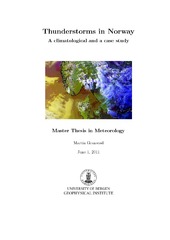Thunderstorms in Norway. A climatological and a case study
Master thesis
Permanent lenke
https://hdl.handle.net/1956/5140Utgivelsesdato
2011-06-01Metadata
Vis full innførselSamlinger
- Geophysical Institute [1198]
Sammendrag
The object of this thesis are thunderstorms in Norway. In the first part, the variability of thunderstorms in time and space is investigated, based on synoptic observations from 60 weather stations in Norway. An analysis of the annual and diurnal variability is carried out, and the long term tendency is explored on the basis of long time series from for five different locations. Some of the results are discussed with respect to the static stability of the atmosphere. There is high variability of the frequency of thunderstorms from one year to another, but there is no clear long term trend in the frequency of thunderstorms in Norway from 1957/58 to 2009. The interannual and diurnal variability confirm that thunderstorms in Southeast Norway have a continental character with a maximum activity in the late afternoon in the summer, while the west coast of Norway has a maritime character with thunderstorms observed through the whole year. The study shows that in the winter, the frequency of thunderstorms is greater in the northern part of the west coast of Norway than in the southern part of the west coast. In the autumn, the relative frequency is opposite: the southern part of the west coast has higher frequency than the northern part. This variability agrees with the frequency of low static stability. In the second part, the case of the 3 July 2009 thunderstorm in Oslo is investigated. The flow is simulated with The Weather Research and Forecasting model (WRF) with different configurations, including 7 microphysical parametrizations and 4 cumulus schemes. A predictability analysis is done for the best configuration. The 3 July case study shows that the convective precipitation is quite sensitive to the resolution, the microphysical parametrizations, the cumulus schemes and the initial data. This real case is described with respect to the temperature, moisture, convective available potential energy (CAPE) and convective inhibition (CIN). Trajectories are also calculated to find the origin of the airmasses. The predictability of the event is good in terms of prediction of the potential for convective precipitation, while the predictability of the high quantity and location of the precipitation is not as good. The 96 hour forecast gives a better forecast than the 72 hours forecast. The reason for this is traced back to a difference in temperature at levels between 600 hPa and 900 hPa over Kattegat.
